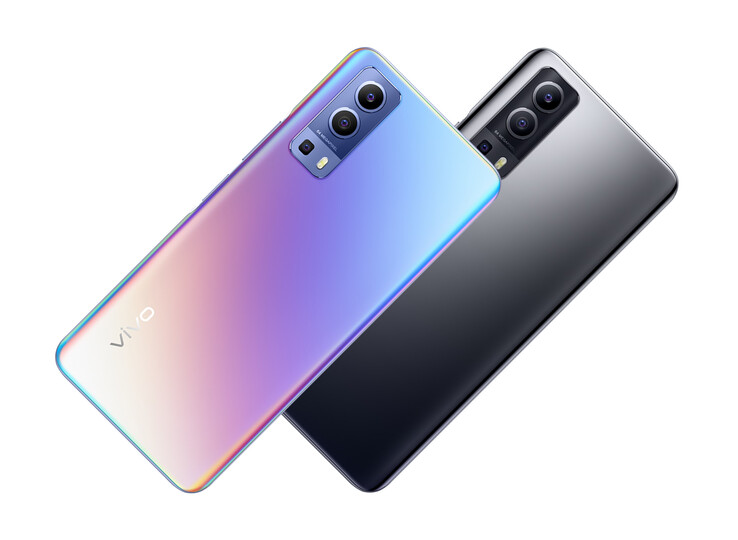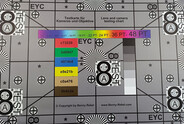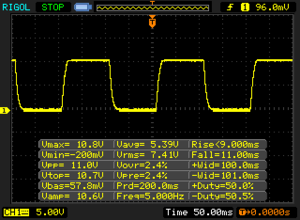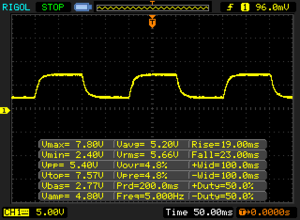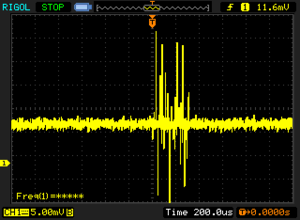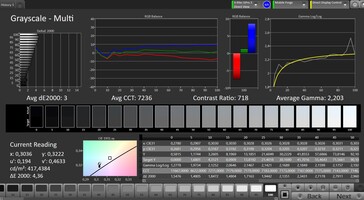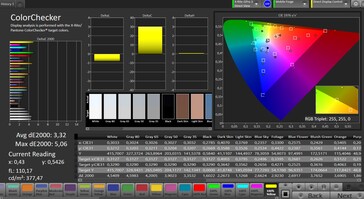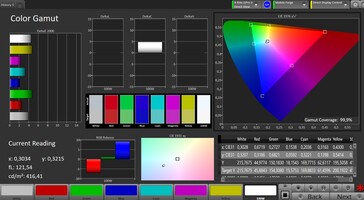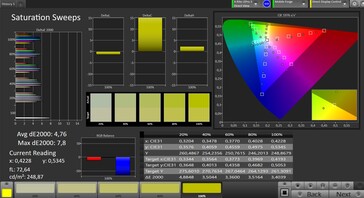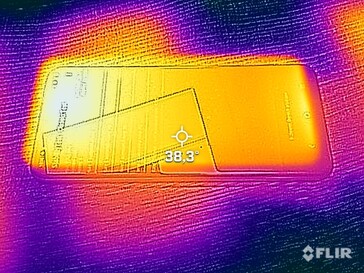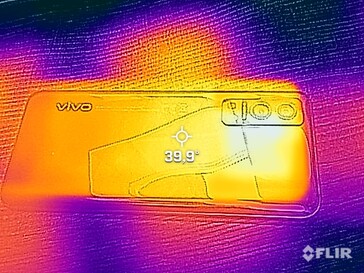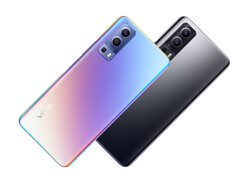Vivo Y72 5G smartphone review - 5G mid-range phone with high-resolution screen
Possible competitors in comparison
Rating | Rating Version | Date | Model | Weight | Drive | Size | Resolution | Price from |
|---|---|---|---|---|---|---|---|---|
| 80 % | 7 | 07/2021 | Vivo Y72 5G Dimensity 700, Mali-G57 MP2 | 193 g | 128 GB UFS 2.1 Flash | 6.58" | 2408x1080 | |
| 79.2 % | 7 | 07/2021 | Motorola Moto G50 SD 480, Adreno 619 | 192 g | 64 GB UFS 2.1 Flash | 6.50" | 1600x720 | |
| 83.7 % | 7 | 04/2021 | Xiaomi Redmi Note 10 Pro SD 732G, Adreno 618 | 193 g | 128 GB UFS 2.2 Flash | 6.67" | 2400x1080 | |
| 79.3 % | 7 | 03/2021 | Samsung Galaxy A32 5G Dimensity 720, Mali-G57 MP3 | 205 g | 64 GB UFS 2.1 Flash | 6.50" | 1600x720 |
Case, equipment and operation - A lot of memory for the money
While Vivo has established itself as one of the largest smartphone manufacturers in Asia, sales in Europe are still comparatively new. The Vivo Y72 5G is one of the devices with which the manufacturer wants to gain market share: A mid-range phone for just under 300 Euros (~$353) that comes with 5G and is supposed to score with a particularly high-resolution camera.
Externally, the smartphone is available in two versions: Dream Glow, which offers a color gradient from creamy white to purple and blue, or Graphite Black, which gradients from light to dark gray and is thus much more discreet. On the front, there is only a small waterdrop notch for the camera.
The plastic casing does not rely on Gorilla Glass (or Vivo did not acquire the license for naming it). Thus, it is difficult to assess how well the display is protected from breakage. Overall, the chassis looks stable and feels comfortable in the hand.
With 8 GB of RAM and 128 GB of UFS 2.1 flash, the Vivo Y72 5G is very well equipped for its price range in terms of storage. NFC for mobile payment services is also supported.
In terms of mobile network diversity, the 5G support is of course noteworthy, and some 4G networks are also supported, but the Vivo Y72 5G is not a real world phone. The Wi-Fi module supports Wi-Fi 5 and thus achieves good transfer rates for the price range of the Vivo Y72 5G.
Android 11 is installed on the smartphone. At the time of testing, the security patches were from June 2021 and are thus still fairly up-to-date. The manufacturer puts its own Funtouch OS interface on top of the normal Android and unfortunately also installs some advertising apps on the smartphone, but they can be uninstalled quite quickly and easily.
| SD Card Reader - average JPG Copy Test (av. of 3 runs) | |
| Average of class Smartphone (10.9 - 77, n=97, last 2 years) | |
| Vivo Y72 5G (Angelbird V60) | |
| Xiaomi Redmi Note 10 Pro (Toshiba Exceria Pro M501) | |
| Motorola Moto G50 (Angelbird V60) | |
Cross Platform Disk Test (CPDT)
| Networking | |
| iperf3 transmit AX12 | |
| Vivo Y72 5G | |
| Samsung Galaxy A32 5G | |
| Motorola Moto G50 | |
| Xiaomi Redmi Note 10 Pro | |
| iperf3 receive AX12 | |
| Samsung Galaxy A32 5G | |
| Vivo Y72 5G | |
| Xiaomi Redmi Note 10 Pro | |
| Motorola Moto G50 | |
Cameras - Unfortunately no UltraHD videos
The Vivo Phone has a 64-megapixel main camera, an 8-megapixel camera with a wide-angle lens, and a 2-megapixel macro camera. Switching between the lenses is only possible via direct selection, otherwise there is only digital zoom.
The pictures of the main camera are usually recorded with pixel binning. This means that 4 pixels each are combined into one pixel. This results in a higher light yield and the resolution is still quite high at 16 megapixels. There is also a special mode if you really want to take pictures with 64 megapixel resolution.
The pictures of the main camera are overall on a high level, but could still be a bit more dynamic and contrasty. Details are displayed well. The lack of dynamics is particularly noticeable in low light and high brightness differences: Hardly anything can be recognized in the dark areas then. At least something can still be seen in the pictures in very dark scenes.
The wide-angle camera takes good pictures, but you should not enlarge it too much, but that is not a good idea for other smartphones, either.
Those who would like to record UltraHD videos will be disappointed with the Vivo phone: Only 1080p with a maximum of 60 fps is possible. However, we like the quality very much here: The autofocus reacts slightly delayed, but then quickly and reliably and the exposure changes without visible gradations.
Image Comparison
Choose a scene and navigate within the first image. One click changes the position on touchscreens. One click on the zoomed-in image opens the original in a new window. The first image shows the scaled photograph of the test device.
Main camera FlowerMain camera EnvironmentMain camera Low LightWide-angle lens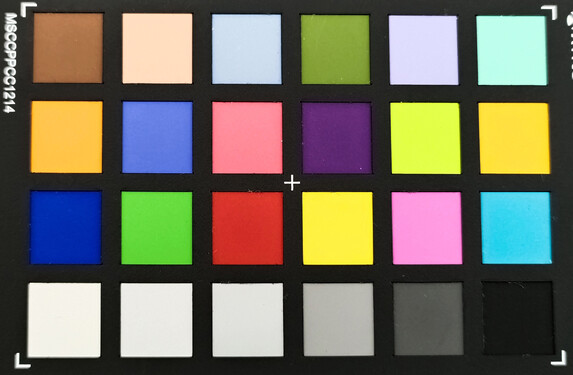
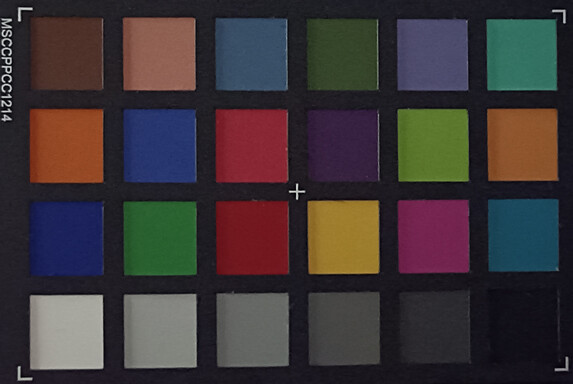
Display - A bit too dark and with little contrast
A Full HD display is by no means a matter of course in this price range. It is nice that Vivo opted for a high-resolution panel. The brightness is usually sufficient for everyday use, but smartphones like the Xiaomi Redmi Note 10 Pro achieve much better peak brightness, which helps visibility especially on sunny days outdoors.
At the same time, the black value and consequently the contrast ratio of the display in the Vivo Y72 5G are not convincing. As a result, colors look a bit pale. The color reproduction on the other hand is decent. At most, the grayscale shows a very slight blue cast.
| |||||||||||||||||||||||||
Brightness Distribution: 87 %
Center on Battery: 419 cd/m²
Contrast: 599:1 (Black: 0.7 cd/m²)
ΔE Color 3.32 | 0.5-29.43 Ø5
ΔE Greyscale 3 | 0.57-98 Ø5.3
99.9% sRGB (Calman 2D)
Gamma: 2.203
| Vivo Y72 5G IPS, 2408x1080, 6.58 | Motorola Moto G50 IPS, 1600x720, 6.50 | Xiaomi Redmi Note 10 Pro OLED, 2400x1080, 6.67 | Samsung Galaxy A32 5G TFT-LCD, 1600x720, 6.50 | |
|---|---|---|---|---|
| Response Times | -52% | 91% | -82% | |
| Response Time Grey 50% / Grey 80% * | 42 ? | 52 ? -24% | 2.8 ? 93% | 66.8 ? -59% |
| Response Time Black / White * | 20 ? | 36 ? -80% | 2.4 ? 88% | 40.8 ? -104% |
| PWM Frequency | 2336000 ? | 490.2 ? | ||
| Screen | 17% | 48% | -14% | |
| Brightness middle | 419 | 340 -19% | 653 56% | 543 30% |
| Brightness | 384 | 325 -15% | 651 70% | 512 33% |
| Brightness Distribution | 87 | 92 6% | 98 13% | 85 -2% |
| Black Level * | 0.7 | 0.18 74% | 0.63 10% | |
| Contrast | 599 | 1889 215% | 862 44% | |
| Colorchecker dE 2000 * | 3.32 | 4.75 -43% | 1.2 64% | 4.9 -48% |
| Colorchecker dE 2000 max. * | 5.06 | 7.53 -49% | 2.9 43% | 8.6 -70% |
| Greyscale dE 2000 * | 3 | 3.9 -30% | 1.8 40% | 6.3 -110% |
| Gamma | 2.203 100% | 2.224 99% | 2.25 98% | 2.23 99% |
| CCT | 7236 90% | 7384 88% | 6426 101% | 8120 80% |
| Total Average (Program / Settings) | -18% /
4% | 70% /
58% | -48% /
-28% |
* ... smaller is better
Display Response Times
| ↔ Response Time Black to White | ||
|---|---|---|
| 20 ms ... rise ↗ and fall ↘ combined | ↗ 9 ms rise | |
| ↘ 11 ms fall | ||
| The screen shows good response rates in our tests, but may be too slow for competitive gamers. In comparison, all tested devices range from 0.1 (minimum) to 240 (maximum) ms. » 37 % of all devices are better. This means that the measured response time is similar to the average of all tested devices (21.5 ms). | ||
| ↔ Response Time 50% Grey to 80% Grey | ||
| 42 ms ... rise ↗ and fall ↘ combined | ↗ 19 ms rise | |
| ↘ 23 ms fall | ||
| The screen shows slow response rates in our tests and will be unsatisfactory for gamers. In comparison, all tested devices range from 0.2 (minimum) to 636 (maximum) ms. » 63 % of all devices are better. This means that the measured response time is worse than the average of all tested devices (33.7 ms). | ||
Screen Flickering / PWM (Pulse-Width Modulation)
| Screen flickering / PWM not detected | |||
In comparison: 53 % of all tested devices do not use PWM to dim the display. If PWM was detected, an average of 17900 (minimum: 5 - maximum: 3846000) Hz was measured. | |||
Performance, emissions and battery life - Others last even longer
With the MediaTek Dimensity 700 Vivo has made a good choice: The review sample's performance is on par with the competition and even a bit higher in some areas. The graphics unit also delivers suitable performance rates. That should be enough for everyday use in most cases. Only very demanding apps and games should show their performance limitations.
The UFS 2.1 memory is overall very fast, only sequential writing has slight weaknesses.
The case heats up to a maximum of 41.5 °C (106.7 °F) after a sustained load. This is still within the usual range, but it could become unpleasant to touch the smartphone in very high ambient temperatures.
The mono speaker on the bottom edge can get quite loud when needed thanks to Vivo's Audio Boost mode, and the sound is then sufficient for a normal-sized room. The sound is decent for such a small speaker, but still quite treble-driven. We preferred to turn down the volume a bit in our test so that the trebles did not thud so unpleasantly in the ear.
External audio devices can be connected via a 3.5 mm audio jack or Bluetooth. However, there is no aptX for improving the wireless audio.
The 5,000 mAh battery is on par with its class in terms of size, and the runtimes in the WLAN test are decent at just over 18 hours. However, the comparison devices from Xiaomi and Samsung can still get a few more hours out of it. The runtime should be sufficient for two days of normal use. Charging is done with a maximum of 18 watts, and a corresponding charger is included in the scope of delivery. Charging takes just under 1:30 hours when battery is empty.
| GFXBench | |
| on screen Aztec Ruins Normal Tier Onscreen (sort by value) | |
| Vivo Y72 5G | |
| Motorola Moto G50 | |
| Xiaomi Redmi Note 10 Pro | |
| Samsung Galaxy A32 5G | |
| Average MediaTek Dimensity 700 (12 - 28, n=11) | |
| Average of class Smartphone (3.6 - 123, n=225, last 2 years) | |
| 1920x1080 Aztec Ruins Normal Tier Offscreen (sort by value) | |
| Vivo Y72 5G | |
| Motorola Moto G50 | |
| Xiaomi Redmi Note 10 Pro | |
| Samsung Galaxy A32 5G | |
| Average MediaTek Dimensity 700 (13 - 16, n=11) | |
| Average of class Smartphone (2.3 - 229, n=225, last 2 years) | |
| on screen Aztec Ruins High Tier Onscreen (sort by value) | |
| Vivo Y72 5G | |
| Motorola Moto G50 | |
| Xiaomi Redmi Note 10 Pro | |
| Samsung Galaxy A32 5G | |
| Average MediaTek Dimensity 700 (7.9 - 17, n=11) | |
| Average of class Smartphone (2.8 - 119, n=225, last 2 years) | |
| 2560x1440 Aztec Ruins High Tier Offscreen (sort by value) | |
| Vivo Y72 5G | |
| Motorola Moto G50 | |
| Xiaomi Redmi Note 10 Pro | |
| Samsung Galaxy A32 5G | |
| Average MediaTek Dimensity 700 (5.2 - 6, n=11) | |
| Average of class Smartphone (0.85 - 94, n=225, last 2 years) | |
| Vivo Y72 5G | Motorola Moto G50 | Xiaomi Redmi Note 10 Pro | Samsung Galaxy A32 5G | Average 128 GB UFS 2.1 Flash | Average of class Smartphone | |
|---|---|---|---|---|---|---|
| AndroBench 3-5 | 318% | 446% | 674% | 507% | 2059% | |
| Sequential Read 256KB | 956 | 392 -59% | 512 -46% | 858 -10% | 760 ? -21% | 1505 ? 57% |
| Sequential Write 256KB | 13.6 | 204.4 1403% | 268 1871% | 381.7 2707% | 297 ? 2084% | 1112 ? 8076% |
| Random Read 4KB | 164.4 | 89.2 -46% | 146.5 -11% | 174.6 6% | 152.9 ? -7% | 247 ? 50% |
| Random Write 4KB | 179.4 | 131.7 -27% | 126.7 -29% | 167.1 -7% | 131.6 ? -27% | 271 ? 51% |
Temperature
(±) The maximum temperature on the upper side is 41.5 °C / 107 F, compared to the average of 35 °C / 95 F, ranging from 21.9 to 56 °C for the class Smartphone.
(±) The bottom heats up to a maximum of 40 °C / 104 F, compared to the average of 33.8 °C / 93 F
(+) In idle usage, the average temperature for the upper side is 29.4 °C / 85 F, compared to the device average of 32.7 °C / 91 F.
Speaker
Vivo Y72 5G audio analysis
(+) | speakers can play relatively loud (86.1 dB)
Bass 100 - 315 Hz
(-) | nearly no bass - on average 23.8% lower than median
(±) | linearity of bass is average (11.7% delta to prev. frequency)
Mids 400 - 2000 Hz
(+) | balanced mids - only 4.5% away from median
(+) | mids are linear (4.7% delta to prev. frequency)
Highs 2 - 16 kHz
(±) | higher highs - on average 6.4% higher than median
(±) | linearity of highs is average (9.8% delta to prev. frequency)
Overall 100 - 16.000 Hz
(±) | linearity of overall sound is average (20.1% difference to median)
Compared to same class
» 26% of all tested devices in this class were better, 9% similar, 65% worse
» The best had a delta of 12%, average was 38%, worst was 134%
Compared to all devices tested
» 46% of all tested devices were better, 8% similar, 45% worse
» The best had a delta of 4%, average was 25%, worst was 134%
Samsung Galaxy A32 5G audio analysis
(+) | speakers can play relatively loud (93.2 dB)
Bass 100 - 315 Hz
(-) | nearly no bass - on average 22.6% lower than median
(+) | bass is linear (3.3% delta to prev. frequency)
Mids 400 - 2000 Hz
(±) | reduced mids - on average 5.8% lower than median
(+) | mids are linear (4.3% delta to prev. frequency)
Highs 2 - 16 kHz
(±) | higher highs - on average 7.1% higher than median
(+) | highs are linear (3.5% delta to prev. frequency)
Overall 100 - 16.000 Hz
(±) | linearity of overall sound is average (17.7% difference to median)
Compared to same class
» 9% of all tested devices in this class were better, 7% similar, 84% worse
» The best had a delta of 12%, average was 38%, worst was 134%
Compared to all devices tested
» 30% of all tested devices were better, 8% similar, 62% worse
» The best had a delta of 4%, average was 25%, worst was 134%
Battery life
| Vivo Y72 5G 5000 mAh | Motorola Moto G50 5000 mAh | Xiaomi Redmi Note 10 Pro 5020 mAh | Samsung Galaxy A32 5G 5000 mAh | Average of class Smartphone | |
|---|---|---|---|---|---|
| Battery Runtime | |||||
| WiFi Websurfing | 1084 | 1198 11% | 753 -31% | 1235 14% | 913 ? -16% |
Pros
Cons
Verdict - Well-equipped 5G midrange
The Vivo Y72 5G offers good storage, 5G, a high-resolution screen, a stylish casing, and good performance rates for its price range. Thus, it fulfills many requirements that one could wish for in a mid-range smartphone.
Of course, the battery should last a bit longer when you look at the comparison devices, and preloaded ad apps are always annoying. The low contrast of both the camera pictures and the screen could also annoy users.
Vivo manages a well-equipped mid-range phone with the Y72 5G that can outperform many rivals.
However, those who do not care about these details should take a closer look at the Asian phone. After all, you get quite a lot for your money, and we did not find any major flaws in our review.
A quick word about the competition: If you do not need 5G, you will get a good price with the Xiaomi Redmi Note 10 Pro and the Samsung Galaxy A32 5G lasts even longer.
Price and availability
The Vivo Y72 5G usually costs €299 (~$352) on the Internet at the time of testing. You can get it from our loaner Cyberport, but also at notebooksbilliger.de or other retailers.
Vivo Y72 5G
-
07/22/2021 v7
Florian Schmitt


 Deutsch
Deutsch English
English Español
Español Français
Français Italiano
Italiano Nederlands
Nederlands Polski
Polski Português
Português Русский
Русский Türkçe
Türkçe Svenska
Svenska Chinese
Chinese Magyar
Magyar
